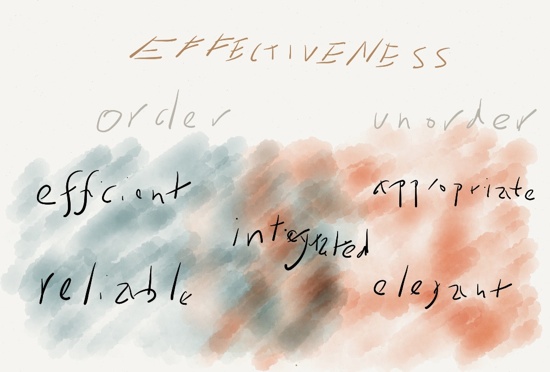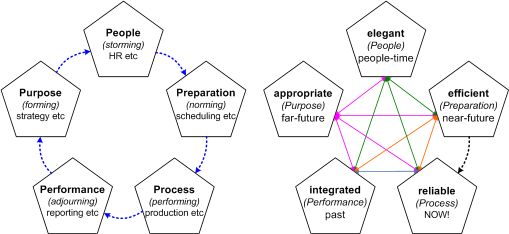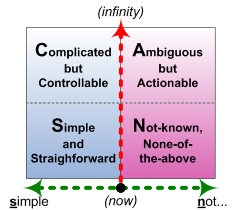Order, unorder and effectiveness
A quick follow-on from the previous post on ‘Complex, complicated and Einstein’s dice‘, in relation to effectiveness in enterprise-architecture.
There’s a common phrasing in business and elsewhere that places efficiency and effectiveness as kind-of opposites: efficiency, we’re told, is doing things right, whereas effectiveness is doing the right things.
I’ve never been very happy about that dichotomy, because to me ‘doing the right things’ is more a question of appropriateness than anything else. To me, effectiveness has a much broader concern, bridging across that dichotomy and more: in essence, effectiveness is doing the right things right.
As I’ve summarised in this slidedeck, I regard effectiveness as the outcome of tying together a whole stream of distinct yet interrelated strands:
- efficient – optimises use of resources, minimises wastage of resources
- reliable – predictable, consistent, self-correcting, supports ‘single source of truth’ etc
- elegant – clarity, simplicity, consistency, self-adapting for human factors
- appropriate – supports and optimises support for business purpose
- integrated – creates, supports and optimises synergy across all systems
In short, effectiveness happens when everything supports everything else.
I’ve used that frame for many years now as a set of ‘lenses’ through which to assess effectiveness within a context. It also fits well with the Five Element frame that I’ve likewise used in much of my work with context-space mapping, where we overlay multiple sets of lenses on the same base-frame to elicit new ideas and views during sensemaking:
For example, my first EA book ‘Real Enterprise Architecture‘ used those two frames above recursively against each other – each segment of either frame looking at the context through each of the ‘lenses’ of the other frame – as a way to assess the architecture- and effectiveness-issues across a whole-of-enterprise space.
And we can also cross-map this view of effectiveness with the SCAN frame:
Or, more to the point, the frame’s core dichotomy of ‘Simple’ versus ‘Not-simple’ – in essence, also the ‘order’ versus ‘unorder’ split – which we can see most easily when everything is compressed down to the moment of ‘now’:
In essence:
- order focusses on doing things right, according to the current logic
- unorder focusses more on doing the right things, making sure that the logic we use matches what we actually need
And what we’re after is a balance between these that gives rise to overall effectiveness: doing the right things right.
Which leads us to a cross-map with those dimensions of effectiveness, somewhat as follows:
- efficient: mostly order – refinement within the scope of defined rules and algorithms
- reliable: mostly order – performs according to the expectations defined by those rules
- elegant: mostly unorder – dealing with people, but also clarifying and reworking the rules themselves
- appropriate: mostly unorder – core-decisions on strategic direction are always emotional (‘feel’) rather than ‘logical’
- integrated: of necessity, bridges between order and unorder
In short:
— Specialists who focus primarily on ‘efficient’or ‘reliable’ are likely to be very good at doing things right – but perhaps not so good at ensuring that they’re doing the right things.
— Specialists who focus primarily on ‘appropriate’ or ‘elegant’ – the human dimensions of effectiveness – are likely to be very good at doing the right things, but perhaps not so good at doing things right.
— If we’re to attain real effectiveness – doing the right things right – we’re also going to need integrators and ‘translators’ who can link between those two sides, and get the people on either side to talk with each other across the order/unorder divide.
Effective architects would sit more naturally in that latter group – the integrators – though do need to cover the whole of the effectiveness-space.
The challenge, of course – and especially at a whole-of-enterprise scope – is that we not only need to be consummate generalists, able to connect with any domain in the enterprise, but we also have to be comfortable with both order and unorder, in all their myriad forms and variations. Kind of a tall order, that – and definitely crazy-making at times… But if we’re to achieve any real effectiveness in the enterprise, someone has to take on that task, don’t they? So welcome to the crazy-house, folks: this game is called ‘finding effectiveness in the enterprise’, and it’s gonna be a wild rollercoaster of a ride… 🙂




Leave a Reply